
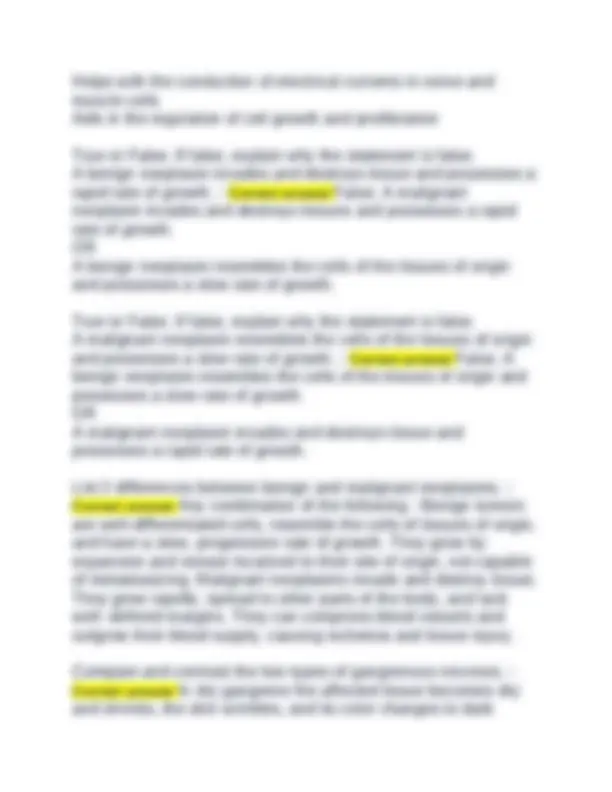
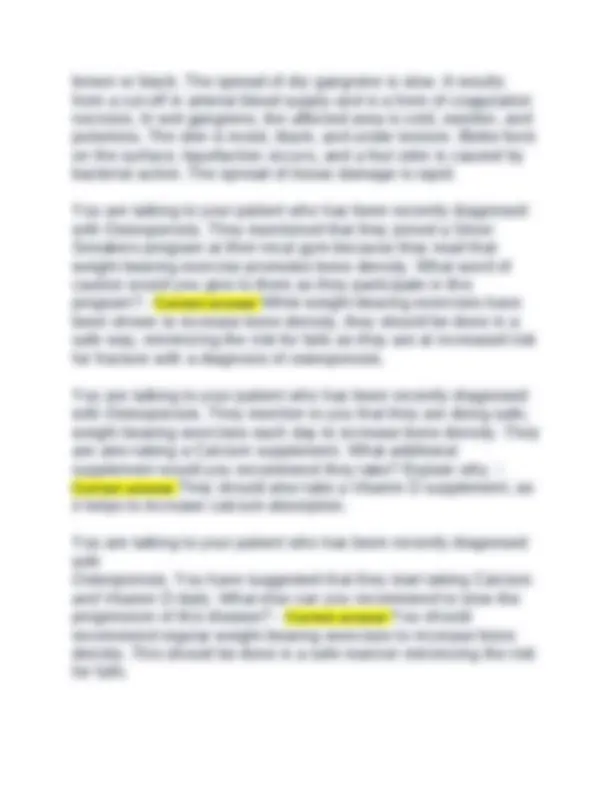
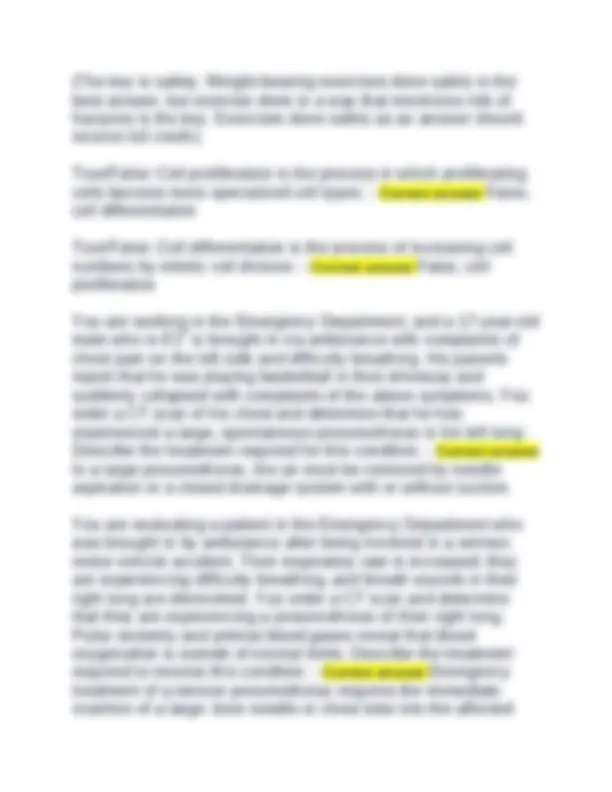
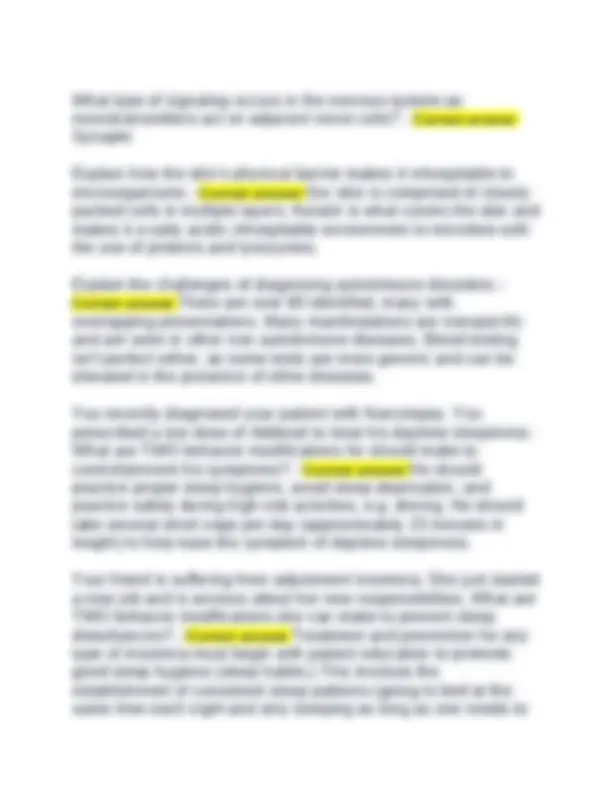
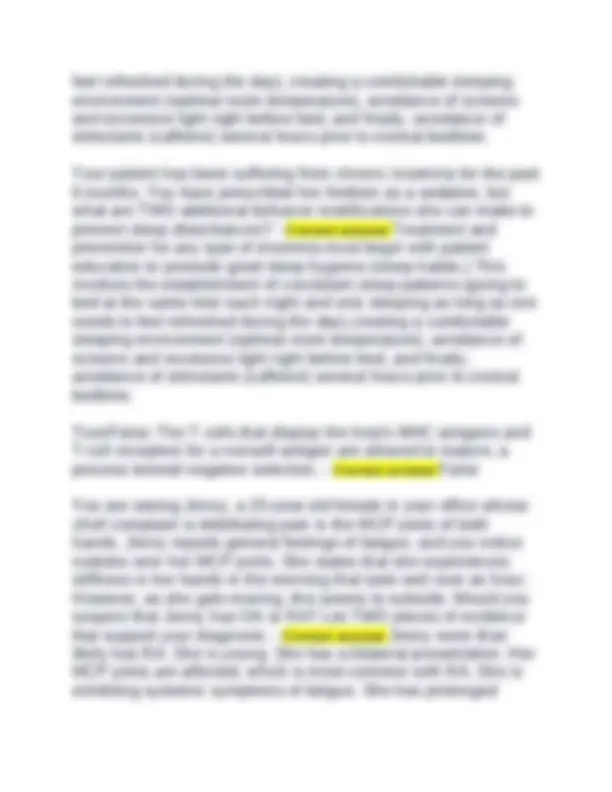
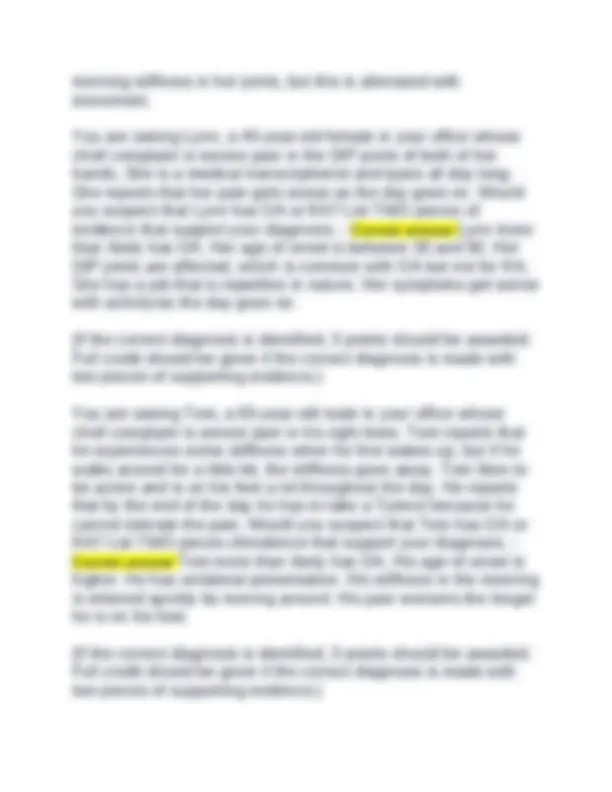
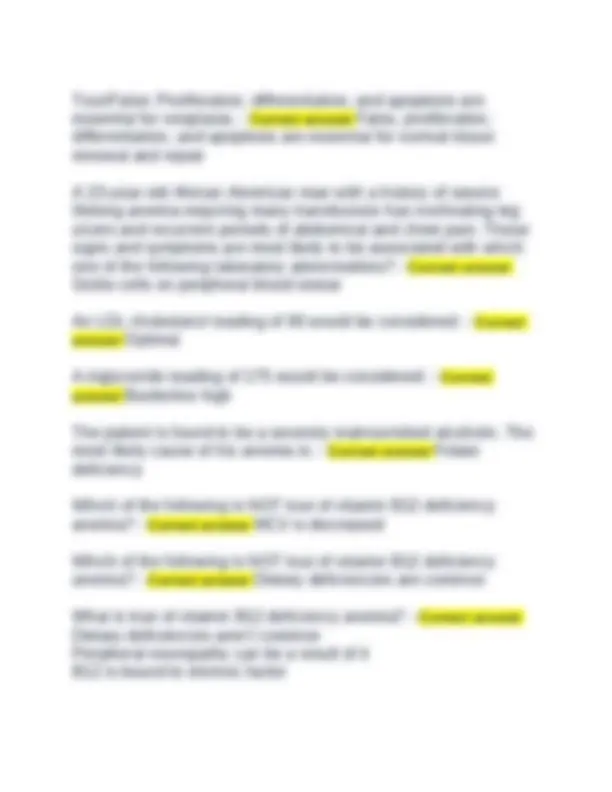
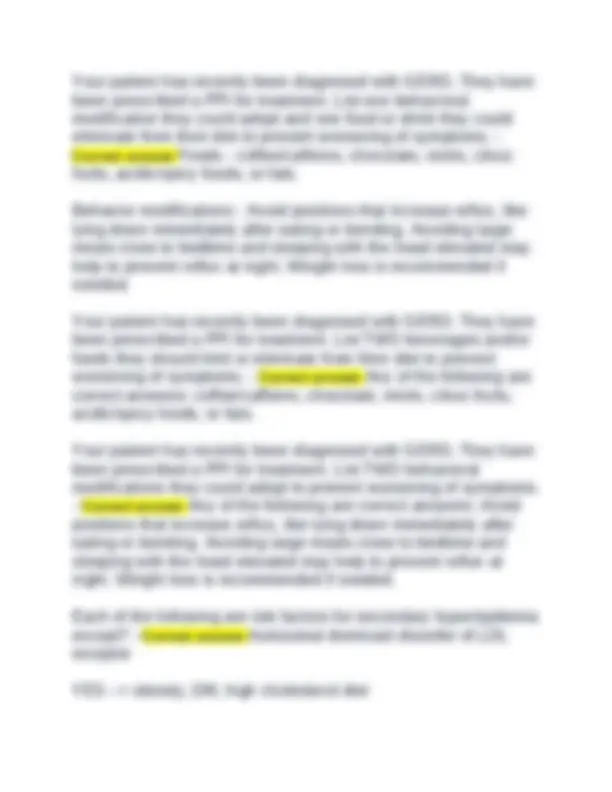
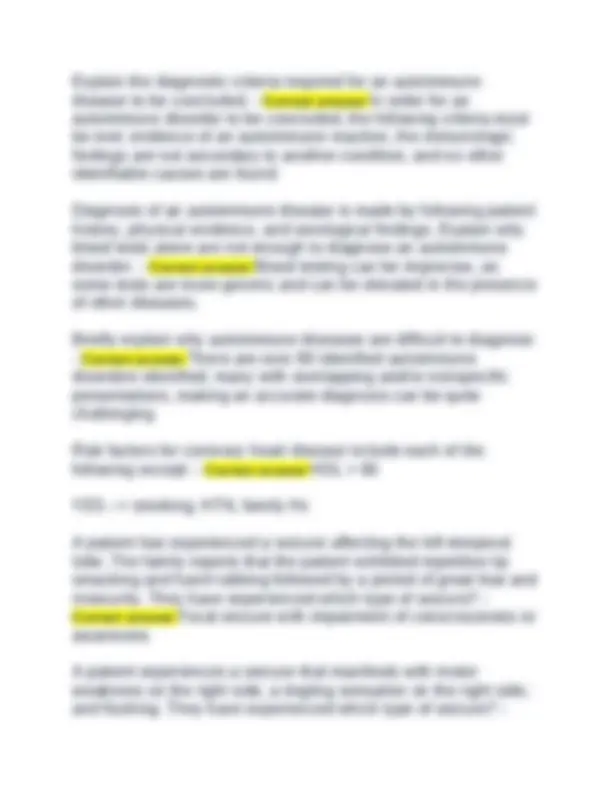
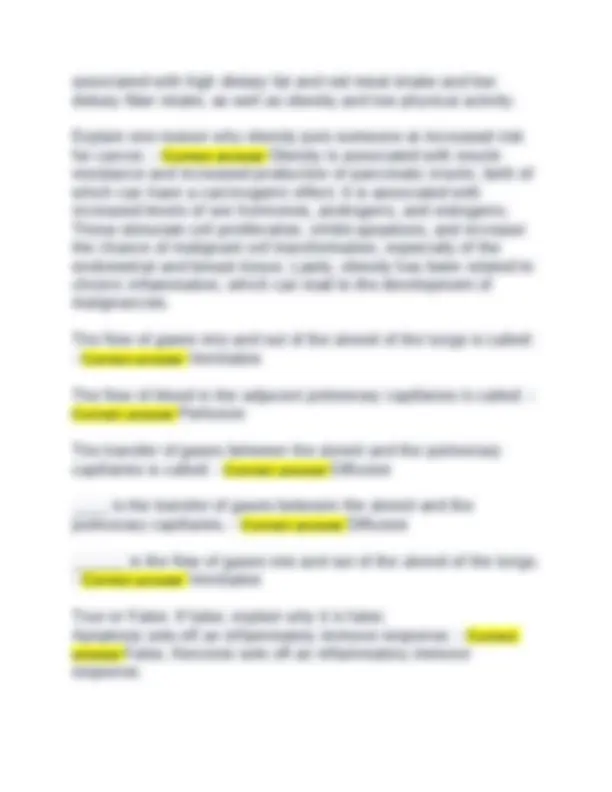
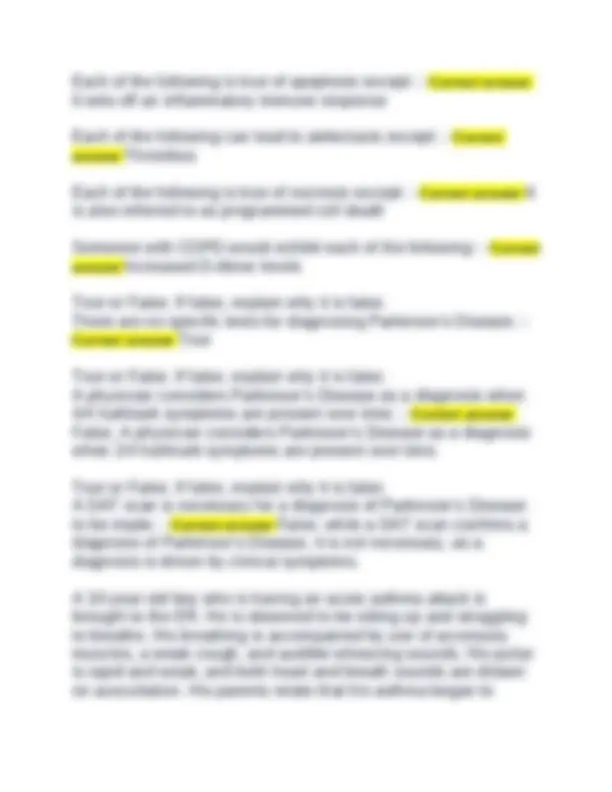
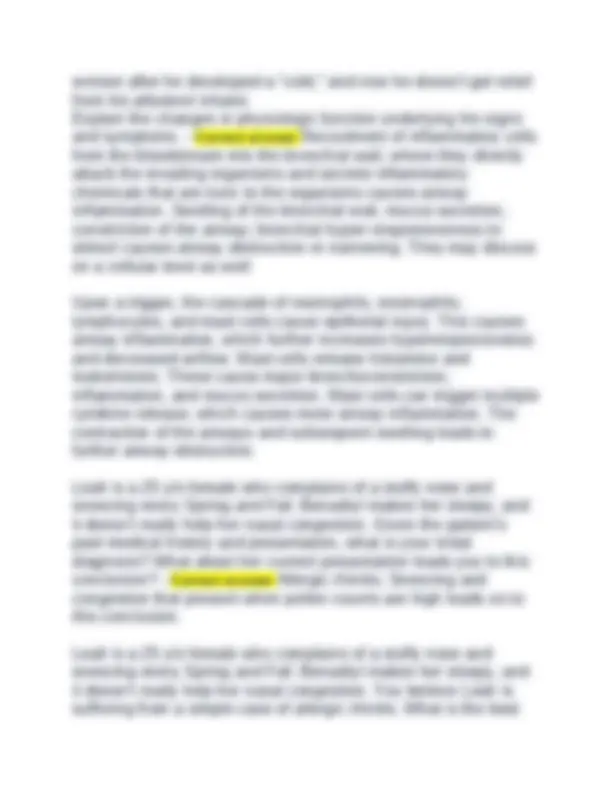
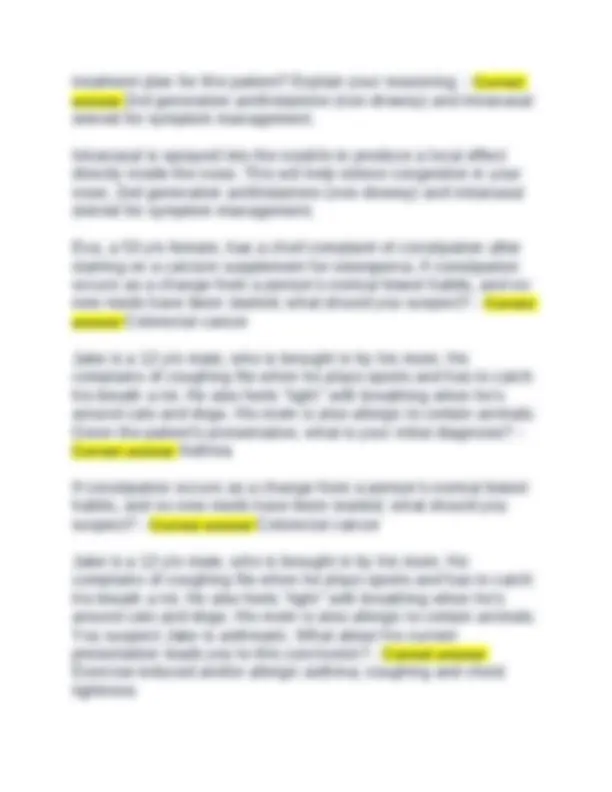
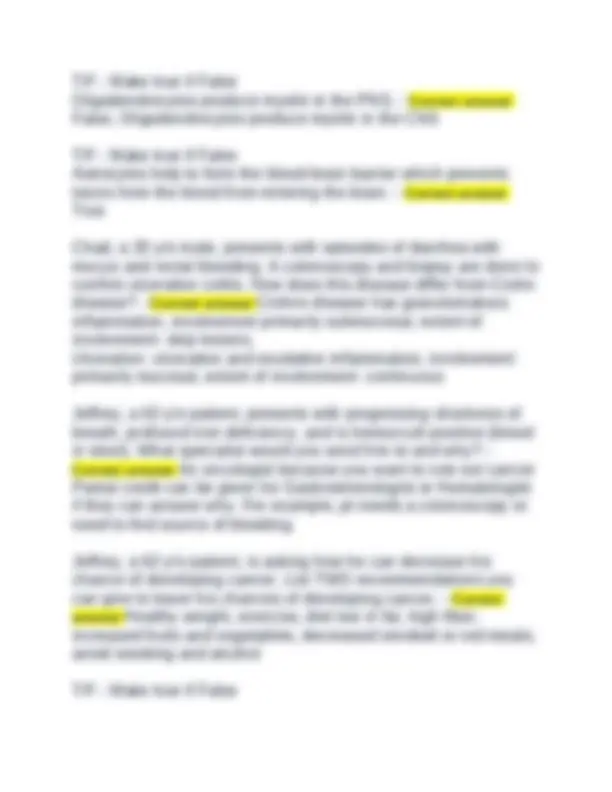
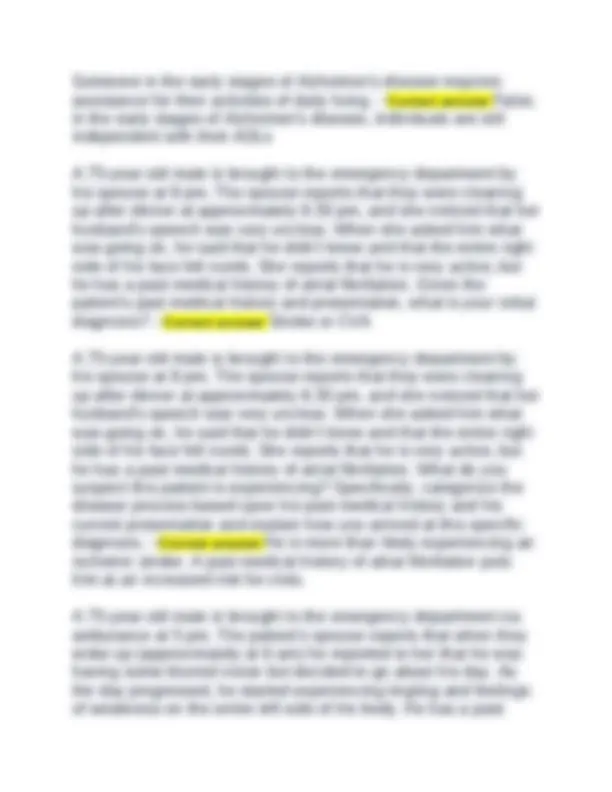
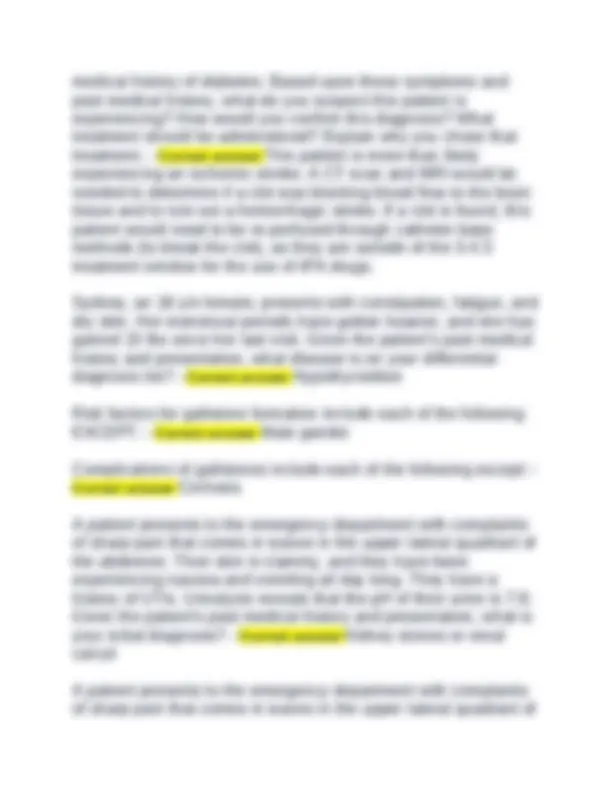
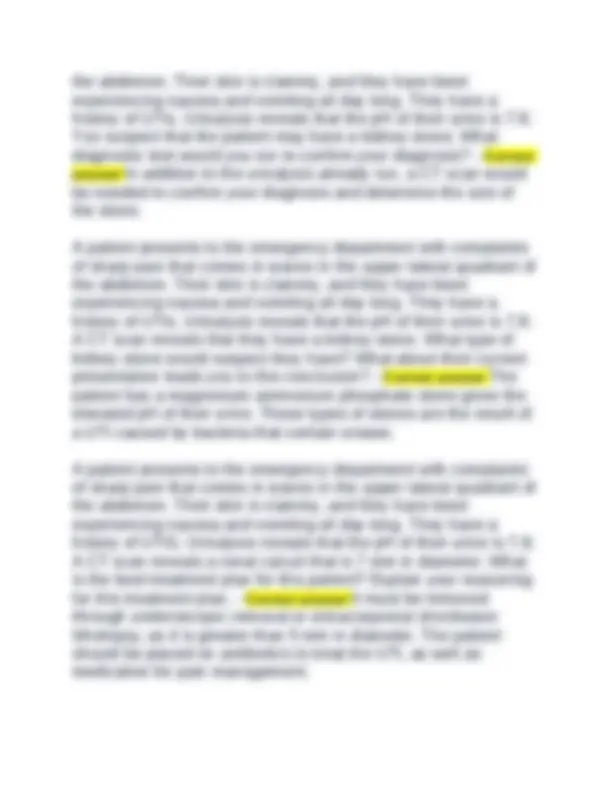
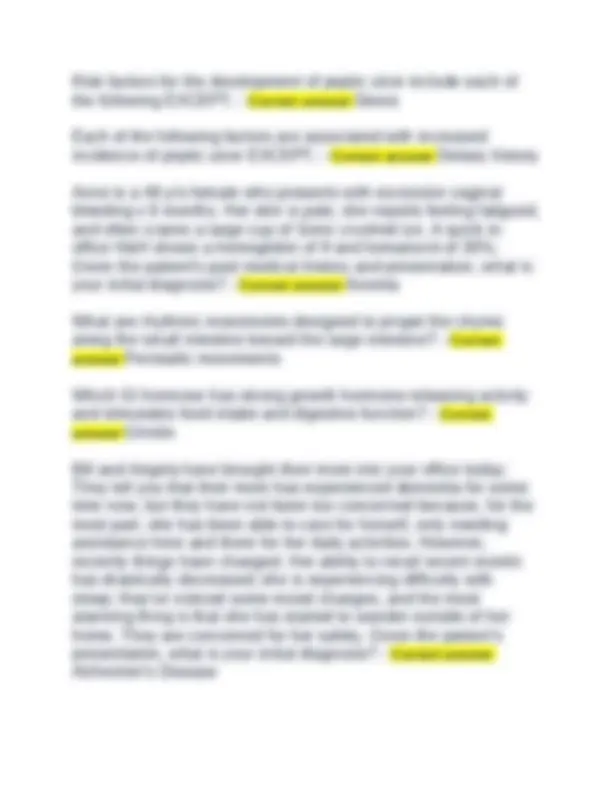
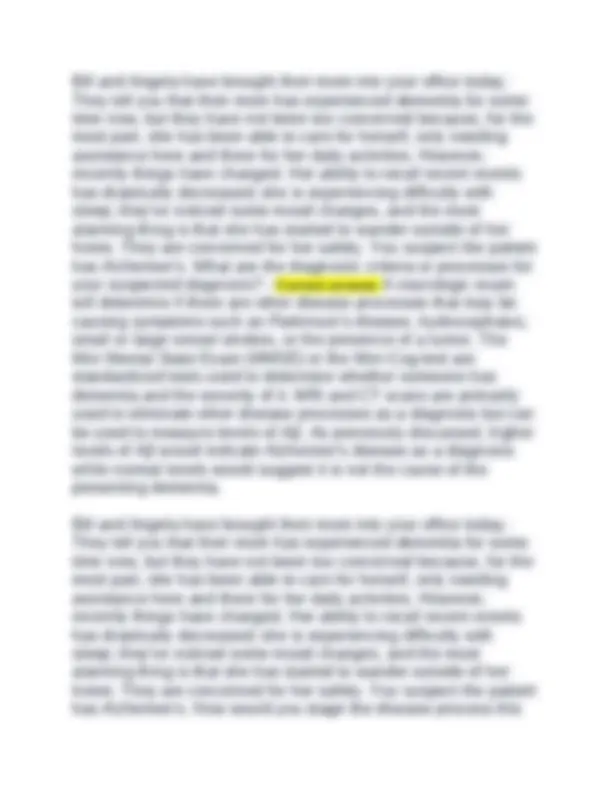
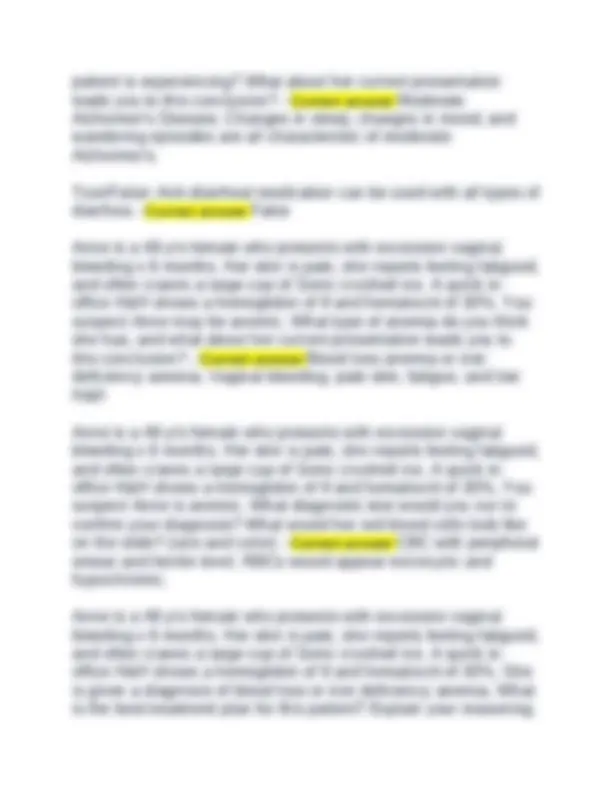
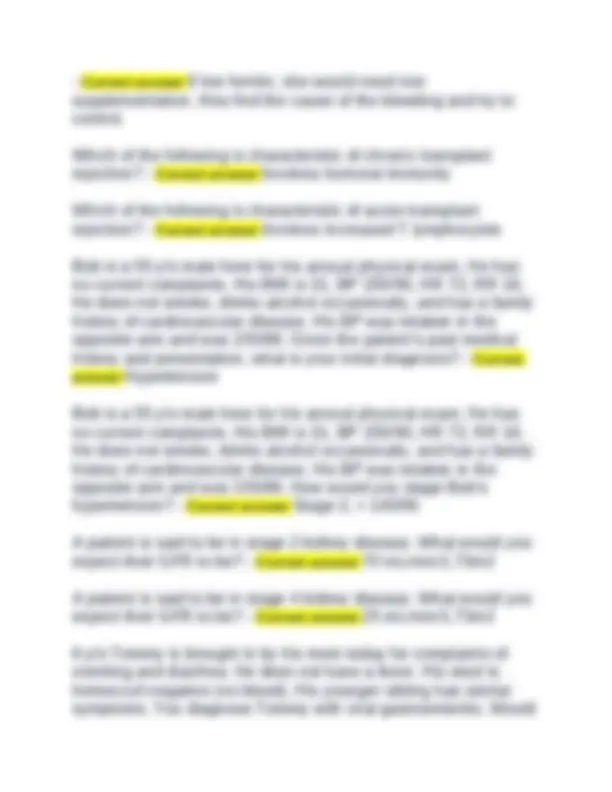
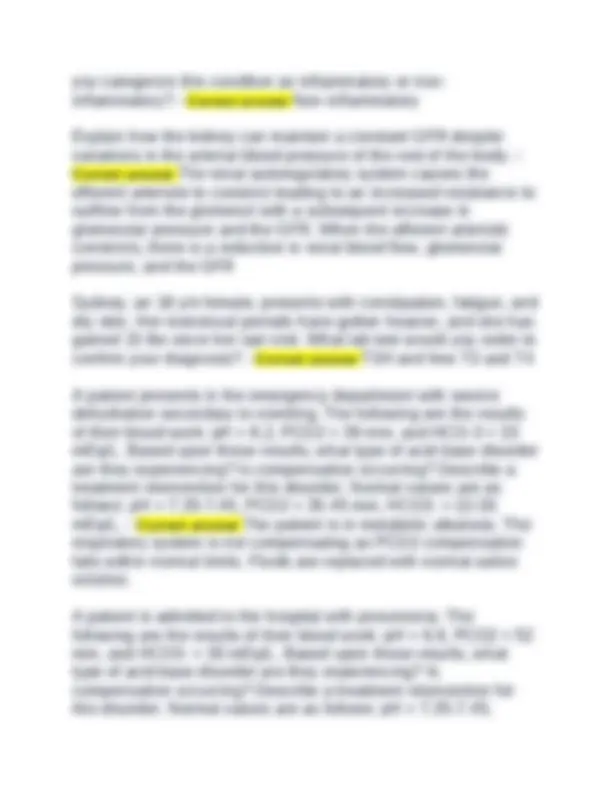
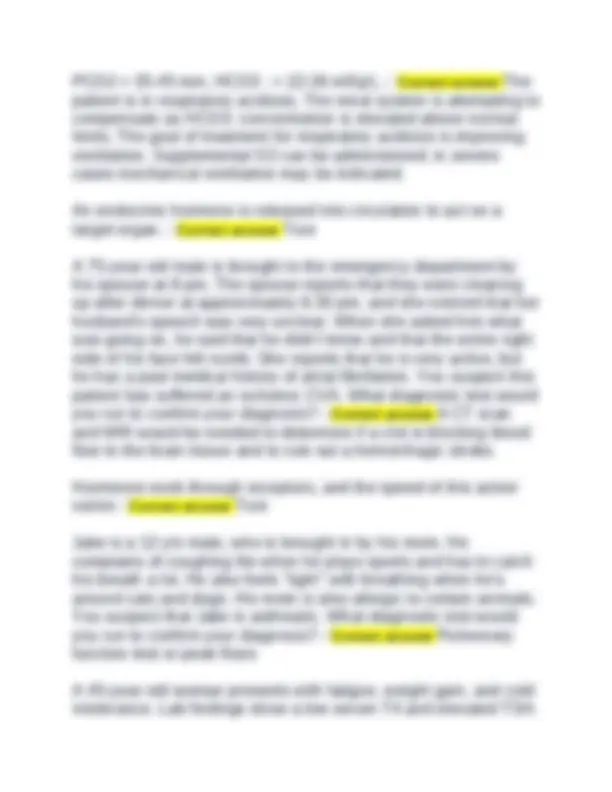
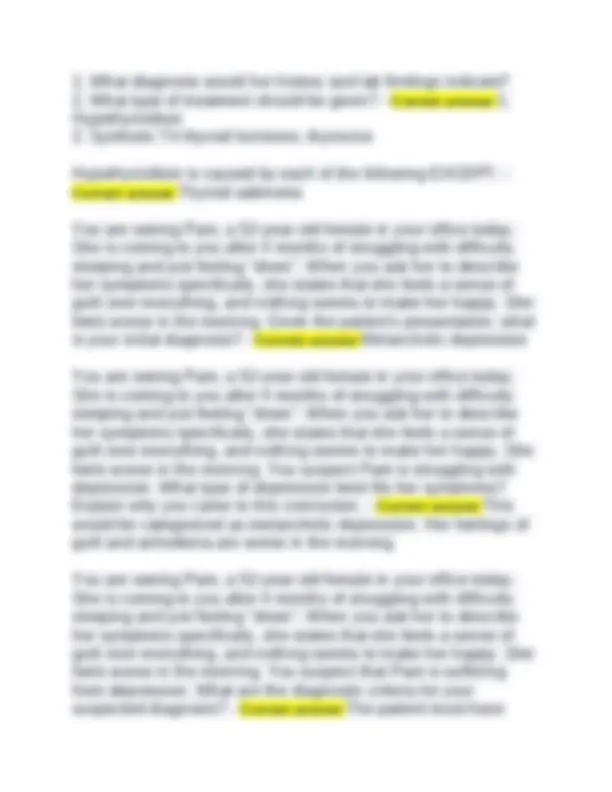
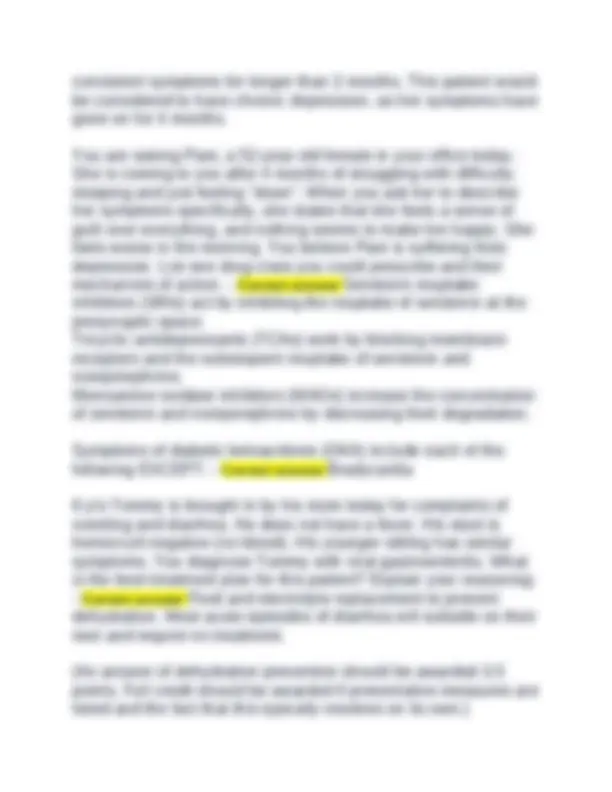
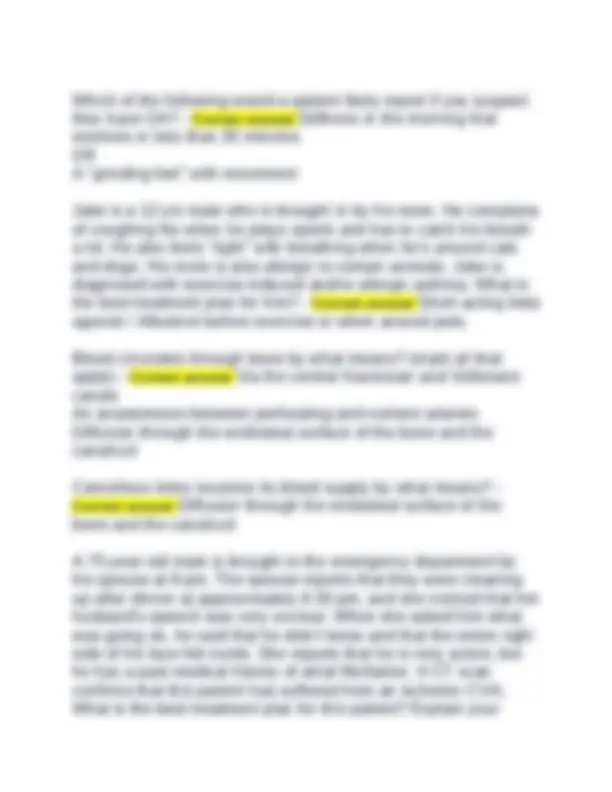
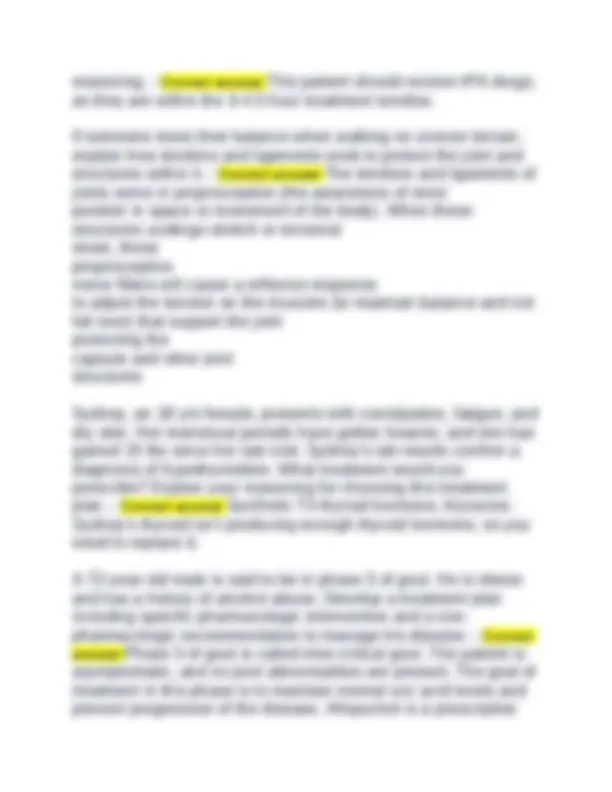
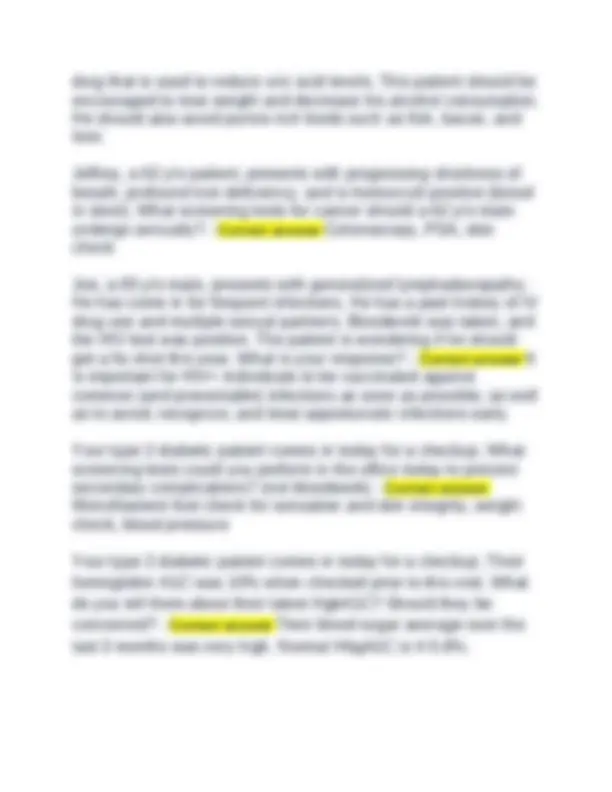


Study with the several resources on Docsity

Earn points by helping other students or get them with a premium plan


Prepare for your exams
Study with the several resources on Docsity

Earn points to download
Earn points by helping other students or get them with a premium plan
Community
Ask the community for help and clear up your study doubts
Discover the best universities in your country according to Docsity users
Free resources
Download our free guides on studying techniques, anxiety management strategies, and thesis advice from Docsity tutors
BIOD331 Pathophysiology Final Exam Questions with 100% Correct Answers. BIOD331 Pathophysiology Final Exam Questions with 100% Correct Answers.
Typology: Exams
1 / 36

This page cannot be seen from the preview
Don't miss anything!





























Taking your child to the pediatrician for their annual well check-up and keeping up with the recommended vaccination schedule would be an example of: - Correct answer Primary prevention You are seeing a patient in your clinic who recently suffered a TIA. Recent diagnostic tests revealed that he has atrial fibrillation. You decide to put him on a blood thinner to prevent a future neurologic event. This would be an example of: - Correct answer Tertiary prevention James is being seen for his first colonoscopy. He turned 50 this year, and his father recently passed away from colon cancer at age 85. This would be an example of: - Correct answer Secondary prevention True/False: Metaplastic cells are not better prepared to survive under stressful circumstances - Correct answer False Fill in the blank: ________ propel chyme along the small intestine toward the large intestine in one direction. - Correct answer Peristaltic movements Fill in the blank: ___________ occlude small portions of the intestinal lumen to push digestive contents forward and backward
You are reading results from a recent blood panel for Fred, a 76- year-old male. His hemoglobin levels are 15.5 g/dL. Would this be considered a normal or abnormal value? - Correct answer Normal You are reading results from a recent blood panel for Susan, a 48-year-old female. Her hemoglobin levels are 7 g/dL. Would this be considered a normal or abnormal value? - Correct answer Abnormal. Normal Hemoglobin levels for a female is 12-15 g/dL You are reading results from a recent blood panel for Jane, a 37- year-old female. Her hemoglobin levels are 13 g/dL. Would this be considered a normal or abnormal value? - Correct answer Normal Which are true of the mitochondria? Select all that apply. - Correct answer It is involved in cellular respiration They play a role in apoptosis Which is NOT true of the cytoskeleton? - Correct answer It includes peroxisomes and proteasomes Which of the following is an active form of Vitamin D? - Correct answer 25-hydroxycholecalciferol Which of the following is an inactive form of Vitamin D? - Correct answer Cholecalciferol Which of the following is synthesized in the kidney and regulates the differentiation of red blood cells within bone marrow? - Correct answer Erythropoietin Which are true of the cell membrane? Select all that apply. - Correct answer Controls the transport of materials from the outside fluids to within
brown or black. The spread of dry gangrene is slow. It results from a cut-off in arterial blood supply and is a form of coagulation necrosis. In wet gangrene, the affected area is cold, swollen, and pulseless. The skin is moist, black, and under tension. Blebs form on the surface, liquefaction occurs, and a foul odor is caused by bacterial action. The spread of tissue damage is rapid. You are talking to your patient who has been recently diagnosed with Osteoporosis. They mentioned that they joined a Silver Sneakers program at their local gym because they read that weight-bearing exercise promotes bone density. What word of caution would you give to them as they participate in this program? - Correct answer While weight-bearing exercises have been shown to increase bone density, they should be done in a safe way, minimizing the risk for falls as they are at increased risk for fracture with a diagnosis of osteoporosis. You are talking to your patient who has been recently diagnosed with Osteoporosis. They mention to you that they are doing safe, weight bearing exercises each day to increase bone density. They are also taking a Calcium supplement. What additional supplement would you recommend they take? Explain why. - Correct answer They should also take a Vitamin D supplement, as it helps to increase calcium absorption. You are talking to your patient who has been recently diagnosed with Osteoporosis. You have suggested that they start taking Calcium and Vitamin D daily. What else can you recommend to slow the progression of this disease? - Correct answer You should recommend regular weight-bearing exercises to increase bone density. This should be done in a safe manner minimizing the risk for falls.
(The key is safety. Weight-bearing exercises done safely is the best answer, but exercise done in a way that minimizes risk of fractures is the key. Exercises done safely as an answer should receive full credit.) True/False: Cell proliferation is the process in which proliferating cells become more specialized cell types. - Correct answer False, cell differentiation True/False: Cell differentiation is the process of increasing cell numbers by mitotic cell division. - Correct answer False, cell proliferation You are working in the Emergency Department, and a 17-year-old male who is 6'2" is brought in via ambulance with complaints of chest pain on the left side and difficulty breathing. His parents report that he was playing basketball in their driveway and suddenly collapsed with complaints of the above symptoms. You order a CT scan of his chest and determine that he has experienced a large, spontaneous pneumothorax in his left lung. Describe the treatment required for this condition. - Correct answer In a large pneumothorax, the air must be removed by needle aspiration or a closed drainage system with or without suction. You are evaluating a patient in the Emergency Department who was brought in by ambulance after being involved in a serious motor vehicle accident. Their respiratory rate is increased; they are experiencing difficulty breathing, and breath sounds in their right lung are diminished. You order a CT scan and determine that they are experiencing a pneumothorax of their right lung. Pulse oximetry and arterial blood gases reveal that blood oxygenation is outside of normal limits. Describe the treatment required to reverse this condition. - Correct answer Emergency treatment of a tension pneumothorax requires the immediate insertion of a large- bore needle or chest tube into the affected
Which of the following are most likely to have arisen from an adult stem cell? - Correct answer Epithelial Each of the following is characteristic of Addison's Disease except? - Correct answer Emotional disturbances Signs and symptoms of Addison's disease include each of the following EXCEPT: - Correct answer Hyperglycemia Which of the following would you expect to find if someone has Addison's Disease? Select all that apply. - Correct answer Decreased cortisol levels Hyperpigmentation of the skin Which of the following would you expect to find if someone has Cushing's Disease? Select all that apply. - Correct answer Increased cortisol levels Buffalo hump
What type of signaling occurs in the nervous system as neurotransmitters act on adjacent nerve cells? - Correct answer Synaptic Explain how the skin's physical barrier makes it inhospitable to microorganisms - Correct answer Our skin is comprised of closely packed cells in multiple layers. Keratin is what covers the skin and makes it a salty acidic inhospitable environment to microbes with the use of proteins and lysozymes. Explain the challenges of diagnosing autoimmune disorders - Correct answer There are over 80 identified, many with overlapping presentations. Many manifestations are nonspecific and are seen in other non-autoimmune diseases. Blood testing isn't perfect either, as some tests are more generic and can be elevated in the presence of other diseases. You recently diagnosed your patient with Narcolepsy. You prescribed a low dose of Adderall to treat his daytime sleepiness. What are TWO behavior modifications he should make to control/prevent his symptoms? - Correct answer He should practice proper sleep hygiene, avoid sleep deprivation, and practice safety during high-risk activities, e.g. driving. He should take several short naps per day (approximately 15 minutes in length) to help ease the symptom of daytime sleepiness. Your friend is suffering from adjustment insomnia. She just started a new job and is anxious about her new responsibilities. What are TWO behavior modifications she can make to prevent sleep disturbances? - Correct answer Treatment and prevention for any type of insomnia must begin with patient education to promote good sleep hygiene (sleep habits.) This involves the establishment of consistent sleep patterns (going to bed at the same time each night and only sleeping as long as one needs to
morning stiffness in her joints, but this is alleviated with movement. You are seeing Lynn, a 40-year-old female in your office whose chief complaint is severe pain in the DIP joints of both of her hands. She is a medical transcriptionist and types all day long. She reports that her pain gets worse as the day goes on. Would you suspect that Lynn has OA or RA? List TWO pieces of evidence that support your diagnosis. - Correct answer Lynn more than likely has OA. Her age of onset is between 30 and 60. Her DIP joints are affected, which is common with OA but not for RA. She has a job that is repetitive in nature. Her symptoms get worse with activity/as the day goes on. (If the correct diagnosis is identified, 3 points should be awarded. Full credit should be given if the correct diagnosis is made with two pieces of supporting evidence.) You are seeing Tom, a 65-year-old male in your office whose chief complaint is severe pain in his right knee. Tom reports that he experiences some stiffness when he first wakes up, but if he walks around for a little bit, the stiffness goes away. Tom likes to be active and is on his feet a lot throughout the day. He reports that by the end of the day he has to take a Tylenol because he cannot tolerate the pain. Would you suspect that Tom has OA or RA? List TWO pieces ofevidence that support your diagnosis. - Correct answer Tom more than likely has OA. His age of onset is higher. He has unilateral presentation. His stiffness in the morning is relieved quickly by moving around. His pain worsens the longer he is on his feet. (If the correct diagnosis is identified, 3 points should be awarded. Full credit should be given if the correct diagnosis is made with two pieces of supporting evidence.)
Which lab value will typically be increased in a viral infection? - Correct answer Lymphocytes Which cell in the blood provides primary hemostasis? - Correct answer Platelets Your patient has serum uric acid levels of 7.5 mg/dL. They are not complaining of pain, and there are no signs of inflammation. What phase of gout would you place them? - Correct answer Asymptomatic hyperuricemia Your patient has serum uric acid levels of 7.5 mg/dL. They are complaining of severe pain in the affected joint that is painful to the touch. What phase of gout would you place them? - Correct answer Acute gout arthritis Your patient has serum uric acid levels of 7.5 mg/dL. They have had multiple gout attacks in the past. They are currently not experiencing joint pain, but you notice visible tophi over their affected joints. What phase of gout would you place them? - Correct answer Chronic tophaceous gout (phase 4) A 9-year-old boy with a peanut allergy was exposed to peanuts. He presents to the emergency room with an anaphylactic reaction. (1) What symptoms might he present with? (2) Does the quantity of exposure mean he will have a more severe reaction? (3) What is the initial immediate treatment? (4) What are 2 things people with anaphylaxis should always carry? - Correct answer (1) Any of the following reactions are accepted. Grade I: erythema and urticaria, with or without angioedema
True/False: Proliferation, differentiation, and apoptosis are essential for neoplasia. - Correct answer False, proliferation, differentiation, and apoptosis are essential for normal tissue renewal and repair A 23-year-old African-American man with a history of severe lifelong anemia requiring many transfusions has nonhealing leg ulcers and recurrent periods of abdominal and chest pain. These signs and symptoms are most likely to be associated with which one of the following laboratory abnormalities? - Correct answer Sickle cells on peripheral blood smear An LDL cholesterol reading of 90 would be considered: - Correct answer Optimal A triglyceride reading of 175 would be considered: - Correct answer Borderline high The patient is found to be a severely malnourished alcoholic. The most likely cause of his anemia is: - Correct answer Folate deficiency Which of the following is NOT true of vitamin B12 deficiency anemia? - Correct answer MCV is decreased Which of the following is NOT true of vitamin B12 deficiency anemia? - Correct answer Dietary deficiencies are common What is true of vitamin B12 deficiency anemia? - Correct answer Dietary deficiencies aren't common Peripheral neuropathy can be a result of it B12 is bound to intrinsic factor
Your patient has recently been diagnosed with GERD. They have been prescribed a PPI for treatment. List one behavioral modification they could adopt and one food or drink they could eliminate from their diet to prevent worsening of symptoms. - Correct answer Foods - coffee/caffeine, chocolate, mints, citrus fruits, acidic/spicy foods, or fats. Behavior modifications - Avoid positions that increase reflux, like lying down immediately after eating or bending. Avoiding large meals close to bedtime and sleeping with the head elevated may help to prevent reflux at night. Weight loss is recommended if needed. Your patient has recently been diagnosed with GERD. They have been prescribed a PPI for treatment. List TWO beverages and/or foods they should limit or eliminate from their diet to prevent worsening of symptoms. - Correct answer Any of the following are correct answers: coffee/caffeine, chocolate, mints, citrus fruits, acidic/spicy foods, or fats. Your patient has recently been diagnosed with GERD. They have been prescribed a PPI for treatment. List TWO behavioral modifications they could adopt to prevent worsening of symptoms.
Correct answer Focal seizure without impairment of consciousness or awareness A patient experiences a seizure that manifests with repetitive hand rubbing and reports of hallucinations right before the seizure occurred. They have experienced which type of seizure? - Correct answer Focal seizure with impairment of consciousness or awareness Patient is found to have the above:
A patient is experiencing kidney damage with a mild decrease in GFR, and their GFR is 60-89 mL/min/1.73m². What stage of kidney disease are they in? - Correct answer 2 Steve is a 55-year-old male who has atherosclerosis. Steve smokes 2 packs of cigarettes per day, and his lipid panel reveals that he has elevated LDL and low HDL levels. List one thing Steve can do to slow the progression of atherosclerosis or mitigate its effects. - Correct answer He could stop smoking and change his diet to decrease his LDL and increase his HDL levels. Steve is a 55-year-old male who has atherosclerosis. Steve is obese, smokes 2 packs of cigarettes per day, and coronary artery disease runs in his family. Steve can make several lifestyle changes to mitigate the effects of atherosclerosis; however, there are things he cannot control. Name one of them. - Correct answer Steve is an older male, and CAD runs in his family. Give a specific example of how our diet can increase our risk for cancer. - Correct answer Any of the following are acceptable answers: While some dietary carcinogens occur naturally in plants (aflatoxins), others are used in the preparation or preservation of food. For instance, when foods are fried in fat that has been reused multiple times, due to the extreme heat, benzo[a] pyrene (and other polycyclic hydrocarbons) are converted to carcinogens. The polycyclic aromatic hydrocarbons are among the most potent and can be found in many common places. They are produced from animal fat when charcoal-broiling meats, are present in smoked meats and fish, and are also present in tobacco smoke. Nitrosamines are formed in foods that are smoked, salted, cured, or pickled using nitrites or nitrates as preservatives. The effects of nitrosamines, however, may be reduced by antioxidants such as vitamin C found in fruits and vegetables. Colon cancer is
Each of the following is true of apoptosis except: - Correct answer It sets off an inflammatory immune response Each of the following can lead to atelectasis except: - Correct answer Thrombus Each of the following is true of necrosis except: - Correct answer It is also referred to as programmed cell death Someone with COPD would exhibit each of the following: - Correct answer Increased D-dimer levels True or False. If false, explain why it is false. There are no specific tests for diagnosing Parkinson's Disease. - Correct answer True True or False. If false, explain why it is false. A physician considers Parkinson's Disease as a diagnosis when 4/4 hallmark symptoms are present over time. - Correct answer False, A physician considers Parkinson's Disease as a diagnosis when 2/4 hallmark symptoms are present over time. True or False. If false, explain why it is false. A DAT scan is necessary for a diagnosis of Parkinson's Disease to be made. - Correct answer False, while a DAT scan confirms a diagnosis of Parkinson's Disease, it is not necessary, as a diagnosis is driven by clinical symptoms. A 10-year-old boy who is having an acute asthma attack is brought to the ER. He is observed to be sitting up and struggling to breathe. His breathing is accompanied by use of accessory muscles, a weak cough, and audible wheezing sounds. His pulse is rapid and weak, and both heart and breath sounds are distant on auscultation. His parents relate that his asthma began to
worsen after he developed a "cold," and now he doesn't get relief from his albuterol inhaler. Explain the changes in physiologic function underlying his signs and symptoms. - Correct answer Recruitment of inflammatory cells from the bloodstream into the bronchial wall, where they directly attack the invading organisms and secrete inflammatory chemicals that are toxic to the organisms causes airway inflammation. Swelling of the bronchial wall, mucus secretion, constriction of the airway; bronchial hyper-responsiveness to stimuli causes airway obstruction or narrowing. They may discuss on a cellular level as well: Upon a trigger, the cascade of neutrophils, eosinophils, lymphocytes, and mast cells cause epithelial injury. This causes airway inflammation, which further increases hyperresponsiveess and decreased airflow. Mast cells release histamine and leukotrienes. These cause major bronchoconstriction, inflammation, and mucus secretion. Mast cells can trigger multiple cytokine release, which causes more airway inflammation. The contraction of the airways and subsequent swelling leads to further airway obstruction. Leah is a 25 y/o female who complains of a stuffy nose and sneezing every Spring and Fall. Benadryl makes her sleepy, and it doesn't really help her nasal congestion. Given the patient's past medical history and presentation, what is your initial diagnosis? What about her current presentation leads you to this conclusion? - Correct answer Allergic rhinitis. Sneezing and congestion that present when pollen counts are high leads us to this conclusion. Leah is a 25 y/o female who complains of a stuffy nose and sneezing every Spring and Fall. Benadryl makes her sleepy, and it doesn't really help her nasal congestion. You believe Leah is suffering from a simple case of allergic rhinitis. What is the best